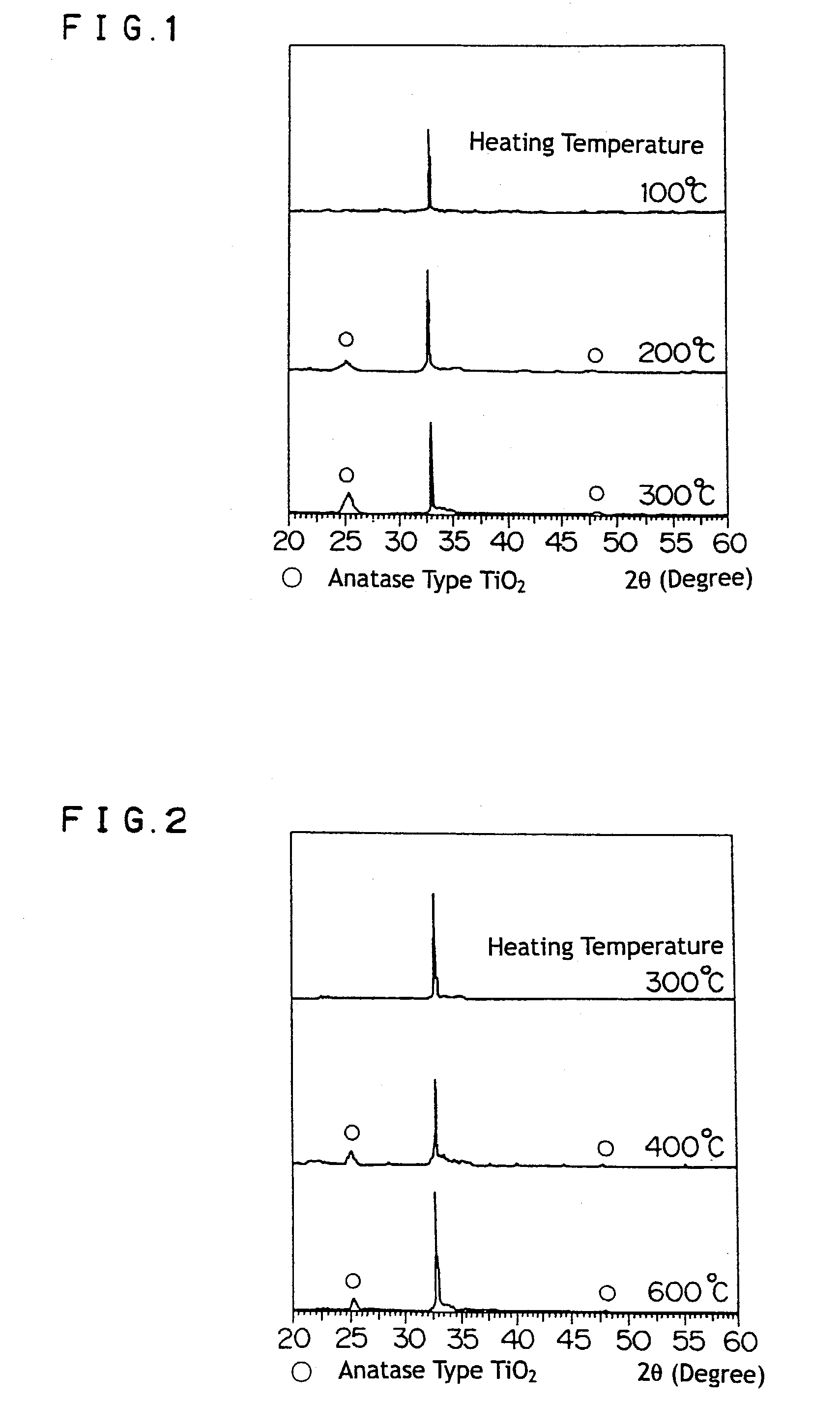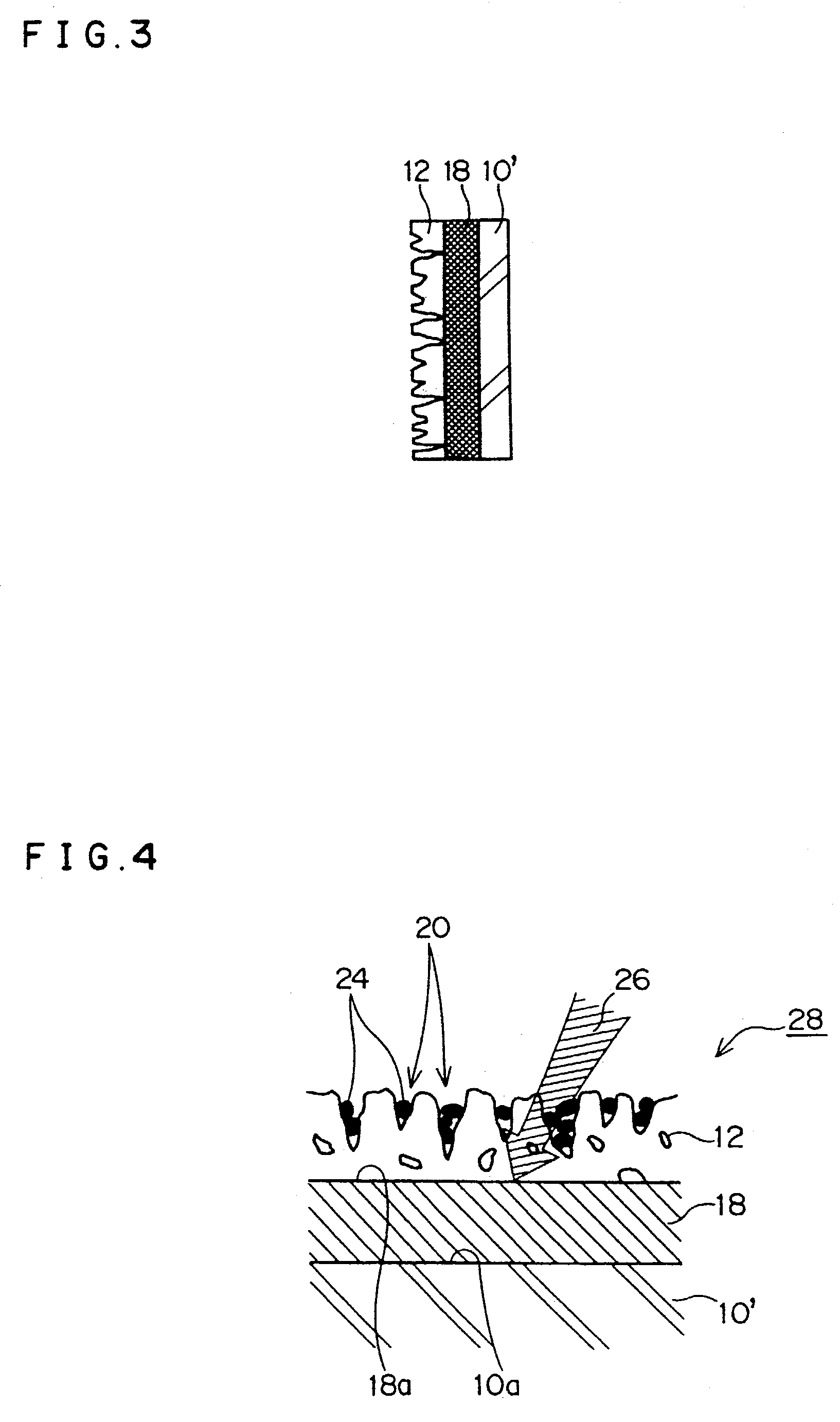Anti-fogging element and method for forming the same
a technology of anti-fogging elements and methods, applied in the direction of optical elements, physical/chemical process catalysts, instruments, etc., can solve the problems of affecting the photocatalytic property, increasing the cost of production, and complicating the process
- Summary
- Abstract
- Description
- Claims
- Application Information
AI Technical Summary
Problems solved by technology
Method used
Image
Examples
example 1
(1) Example 1
[0041] (FIG. 7)
[0042] An automobile outer mirror 30 is configured as a door mirror or a fender mirror. The outer mirror 30 possesses a mirror body 32 having a mirror assembly 34 accommodated therein. The mirror assembly 34 is composed of a transparent glass substrate 10 having a TiO.sub.2 film 18 and a porous SiO.sub.2 film 12 formed on the front surface of the glass substrate 10, and a reflecting film 36 such as Cr or Al film formed on the rear surface of the glass substrate 10. The image behind the automobile penetrates through the SiO.sub.2 film 12, the TiO.sub.2 film 18 and the transparent glass substrate 10, and is reflected upon the reflecting film 36 to be led to the driver's eye via a reverse path. Organic substances etc., entering into the openings of the pores of the SiO.sub.2 film 12 and then adhered therein are decomposed by the oxidation-reduction reaction cause by the photocatalytic reaction on the TiO.sub.2 film 18.
example 2
(2) Example 2
[0043] (FIG. 8)
[0044] A mirror assembly 40 of an automobile outer mirror 30 is composed of a transparent glass substrate 10 having a TiO.sub.2 film 18 and a porous SiO.sub.2 film 12 formed on the front surface of the glass substrate 10, and a reflecting film 36 such as Cr or Al film formed on the rear surface of the glass substrate 10. Over substantially the entire area of the rear surface of the reflecting film 36, a panel-like heater 42 is bonded by mean of an adhesive or a bonding agent. Current is supplied to the panel-like heater from a power source 44. If the panel-like heater 40 comprises, for example, a PTC (positive characteristic thermister) panel heater, it can be directly driven by an automobile battery and, thus, no temperature control circuit or the like is required. The PTC panel heater is composed of a polymeric sheet-like heating element having PCT characteristics imparted thereto (for example, electrically conductive resin in which electrodes made of e...
example 3
(3) Example 3
[0045] (FIG. 9)
[0046] A mirror assembly 48 of an automobile outer mirror 46 is composed of a transparent glass substrate 10 having a transparent electrode film 50 such as ITO as a heating element, a TiO.sub.2 film 18 and a porous SiO.sub.2 film 12 formed on the front surface of the glass substrate 10 in this order, and a reflecting film 36 such as Cr or Al film formed on the rear surface of the glass substrate 10. Clip electrodes 54 and 56 are mounted in the upper and lower portions of the laminated transparent glass substrate 10 and the transparent electrode film 50. By supplying current from a power source 44 to the transparent electrode film 50, the transparent electrode 50 is heated to effectively remove the water droplets spread over the SiO.sub.2 film 12 in a thin film state.
PUM
| Property | Measurement | Unit |
|---|---|---|
| temperature | aaaaa | aaaaa |
| temperature | aaaaa | aaaaa |
| temperature | aaaaa | aaaaa |
Abstract
Description
Claims
Application Information
 Login to View More
Login to View More - R&D
- Intellectual Property
- Life Sciences
- Materials
- Tech Scout
- Unparalleled Data Quality
- Higher Quality Content
- 60% Fewer Hallucinations
Browse by: Latest US Patents, China's latest patents, Technical Efficacy Thesaurus, Application Domain, Technology Topic, Popular Technical Reports.
© 2025 PatSnap. All rights reserved.Legal|Privacy policy|Modern Slavery Act Transparency Statement|Sitemap|About US| Contact US: help@patsnap.com



